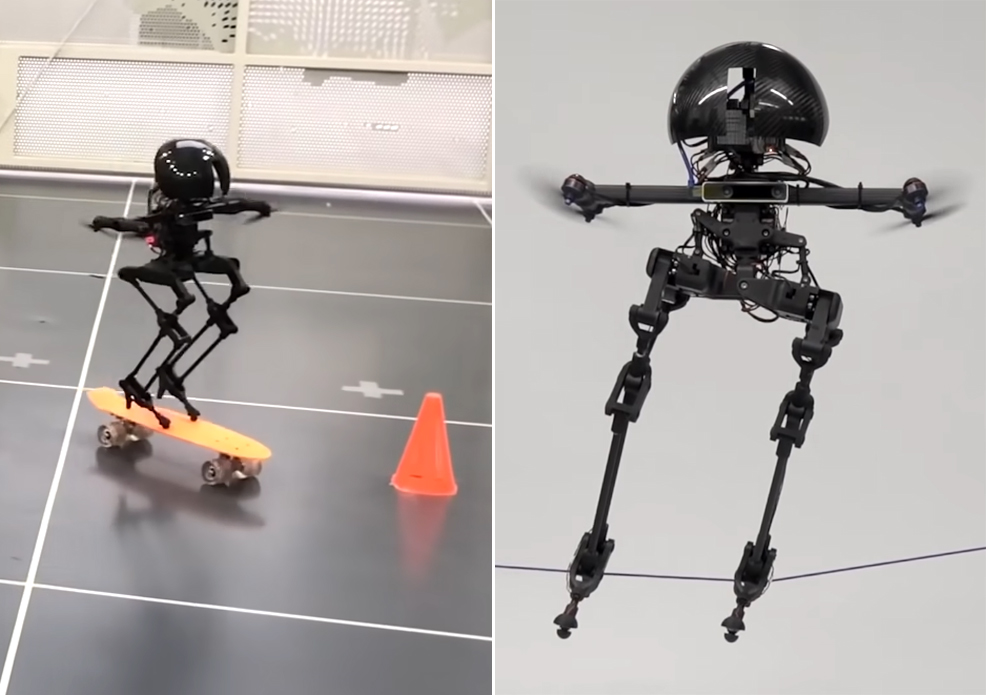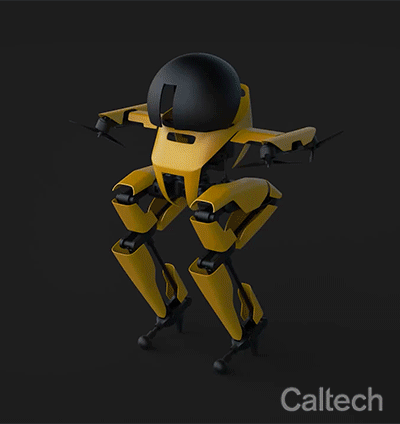
9th October 2021 Bipedal robot can ride a skateboard and walk a slackline Researchers at the California Institute of Technology (Caltech) have built a bipedal robot that combines walking with flying to create a new type of locomotion, making it exceptionally nimble and capable of complex movements. Part walking robot, part flying drone, the newly developed LEONARDO (short for LEgs ONboARD drOne, or LEO for short) can walk a slackline, hop, and even ride a skateboard. Developed by a team at Caltech's Center for Autonomous Systems and Technologies (CAST), LEO is the first robot that uses multi-joint legs and propeller-based thrusters to achieve a fine degree of control over its balance. "We drew inspiration from nature. Think about the way birds are able to flap and hop to navigate telephone lines," explained Soon-Jo Chung, Professor of Aerospace and Control and Dynamical Systems. "A complex yet intriguing behaviour happens as birds move between walking and flying. We wanted to understand and learn from that."
"Robots with a multimodal locomotion ability are able to move through challenging environments more efficiently than traditional robots by appropriately switching between their available means of movement," said Kyunam Kim, postdoctoral researcher at Caltech. "In particular, LEO aims to bridge the gap between the two disparate domains of aerial and bipedal locomotion that are not typically intertwined in existing robotic systems." By using a hybrid that is somewhere between walking and flying, the team achieved the best of both worlds in terms of locomotion. LEO's lightweight legs take stress off of its thrusters by supporting the bulk of the weight, but because the thrusters are controlled synchronously with leg joints, LEO has uncanny balance. "Based on the types of obstacles it needs to traverse, LEO can choose to use either walking or flying, or blend the two as needed," said Patrick Spieler, a former member of Chung's research group who is currently at the Jet Propulsion Laboratory, which is managed by Caltech for NASA. "In addition, LEO is capable of performing unusual locomotion manoeuvres that even in humans require a mastery of balance – like walking on a slackline and skateboarding." Next, the team plans to improve the performance of LEO by creating a more rigid leg design that supports more of the robot's weight and increases the thrust force of the propellers. In addition, they hope to make LEO more autonomous so that the robot can understand how much of its weight is supported by legs and how much needs to be supported by propellers when walking on uneven terrain.
The researchers also plan to equip LEO with a newly developed drone landing control algorithm that utilises deep neural networks. With a better understanding of the environment, LEO could make its own decisions about the best combination of walking, flying, or hybrid motion that it should use to move from one place to another based on what is safest and what uses the least amount of energy. "Right now, LEO uses propellers to balance during walking, which means it uses energy fairly inefficiently. We are planning to improve the leg design to make LEO walk and balance with minimal aid of propellers," said Elena-Sorina Lupu, a graduate student who will continue working on LEO throughout her PhD program. In the real world, the technology developed for LEO could lead to adaptive landing gear systems composed of controlled leg joints for aerial robots and other types of flying vehicles. The team envisions that future Mars rotorcraft could be equipped with legged landing gear, so that the body balance of these aerial robots can be maintained as they land on sloped or uneven terrains, thereby reducing the risk of failure under challenging landing conditions. A paper on the LEO robot is published this week and is featured on the October 2021 cover of Science Robotics.
Comments »
If you enjoyed this article, please consider sharing it:
|








